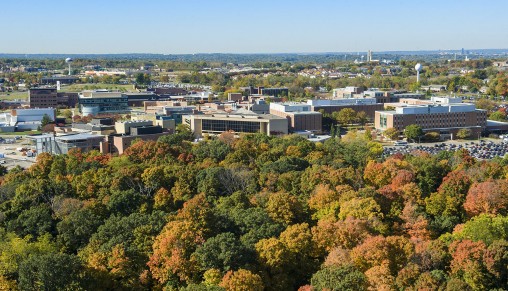Wright State University has more than a $1 billion annual economic impact on the region and supports 14,700 jobs, significantly growing its financial clout from five years earlier, according to a new study.
The study was conducted by the Southwestern Ohio Council for Higher Education for fiscal 2016, which encompasses Wright State’s 2015-16 academic year.
Wright State’s $1 billion-plus economic impact represents nearly 15 percent of the $7.3 billion generated in a 20-county region by the 21 colleges and universities that are members of SOCHE. Those members include the University of Dayton and University of Cincinnati.
“This study shows that we are clearly a leader in driving the economy in this region,” said Wright State President Cheryl B. Schrader.
The study measured the impact of Wright State’s Dayton Campus in the Dayton Metropolitan Statistical Area, a region that includes Greene, Montgomery, Miami and Preble counties. It also measured the impact of the Lake Campus in Mercer County.
Wright State’s $1 billion-plus impact was created by its operations, student spending and capital expenditures. The university directly supported 10,002 jobs and indirectly supported another 4,685, which led to about $421.2 million in wages being paid in the region.
The Lake Campus alone produced an economic impact of $39.9 million and supported the employment of 577 workers and $12.4 million in total wages. It generated $3.6 million in tax revenues, $468,000 of which went to local governments and $1.5 million to the state.
In fiscal 2011, Wright State’s total economic impact was $815 million, according to a previous SOCHE study. The university accounted for 7,511 jobs and had a total impact on wages of $342 million over the period, which encompassed Wright State’s 2010-11 academic year.
In fiscal 2016, Wright State directly employed 7,178 workers, which led to the generation of about $66.9 million in local, state and federal sales, earnings and property taxes. More than 11 percent, or over $7 million, went to local governments; and more than 40.5 percent, or over $25.6 million, to the state.
Also in fiscal 2016, Wright State spent $408 million on operations at its Dayton and Lake campuses.
Wright State also made more than $33.5 million in capital expenditures, of which $15.7 million remained in the Greene, Montgomery, Miami and Preble county economy and $658,000 in the Mercer County economy. This spending led to further local sales of about $10.3 million for a total impact of $26.7 million.
Operations at the Dayton Campus that retained and supported students from the four-county region who may have gone elsewhere for post-secondary education increased economic activity by $335 million, supported 5,310 jobs and resulted in $155.6 million in wages. Supporting non-local students increased economic activity by nearly $193.6 million and led to 3,362 jobs paying total annual wages of $101.5 million.
Students from the four-county region themselves spent an estimated $165.8 million in the area, which led to further expenditures of $88.4 million and a total impact of more than $254.2 million. The student spending supported an estimated 2,608 jobs in local businesses paying a total of $70.5 million in wages.
Spending by non-local students was estimated to have increased total economic output by $90.5 million and supported 936 jobs at local businesses paying total annual wages of $25.6 million.
Operations at the Lake Campus that retained and supported students from Mercer County who may have gone elsewhere for post-secondary education increased economic activity by $3.8 million, supported 90 jobs and resulted in $1.6 million in wages. Supporting non-local students increased economic activity by more than $10.1 million and led to 241 jobs paying total annual wages of more than $4.4 million.
Students from Mercer County spent an estimated $6.2 million in the area, which led to further expenditures of $1.4 million and a total impact of $7.6 million. The student spending supported an estimated 73 jobs in local businesses paying a total of $1.8 million in wages.
Spending by non-local students was estimated to have increased total economic output by more than $17.4 million and supported 167 jobs at local businesses paying total annual wages of $4.2 million.


 Heavy metal learning
Heavy metal learning  State grants to bolster Wright State’s electric vehicle and advanced manufacturing training for students
State grants to bolster Wright State’s electric vehicle and advanced manufacturing training for students  Wright State partners with local universities, hospitals to expand mental health care for students
Wright State partners with local universities, hospitals to expand mental health care for students  Wright State students, first responders team up for Halloween event
Wright State students, first responders team up for Halloween event  Explore Wright State Day welcomes hundreds of future Raiders
Explore Wright State Day welcomes hundreds of future Raiders 